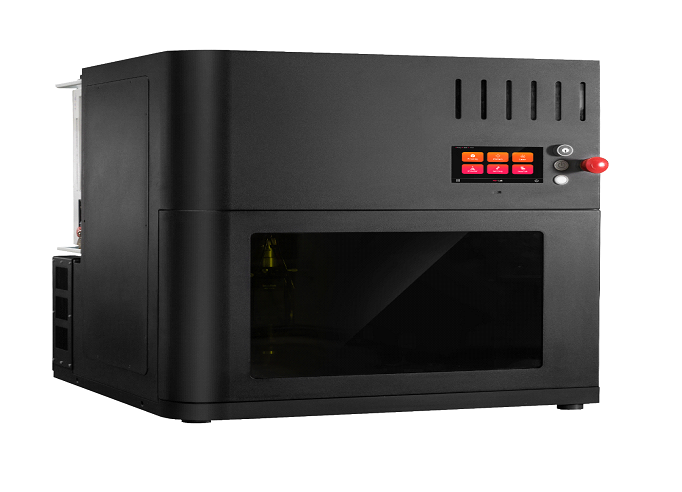Register now for our Additive Manufacturing Advantage online event for insights on AM developments in aerospace, space, and defense sectors from industry leaders!
Partnering with Korea Aerospace Research Institute (KARI), South Korean industrial 3D printing solutions provider InssTek has developed a 3-ton multi-material rocket nozzle and a rocket nozzle extension.
Leveraging Directed Energy Deposition (DED), the components were manufactured using materials suited for each part. Described as the main body, the multi-material rocket nozzle includes an inner part made of Al-Bronze (Cu alloy) with a cooling channel at 1 mm intervals, and an outer part made of Inconel 625 (Ni alloy). In addition, the rocket nozzle extension is made from C-103, an Nb Alloy.
Development and testing for 3D printed rocket nozzles
This development follows extensive testing, including successful combustion trials of the C-103 rocket nozzle extension and multiple firings of the multi-material rocket nozzle. These components have been integrated into a single, high-performance unit.
Multi-material 3D printing technology played a crucial role, enabling the creation of intricate structures and functionalities essential for the efficiency and reliability of rocket engine components. This approach allows for solutions that meet the complex demands of modern aerospace engineering, such as optimizing thermal management and ensuring structural integrity.
Apart from InssTek, NASA successfully 3D printed and tested a rocket engine nozzle as part of its RAMFIRE project, funded by NASA’s Space Technology Mission Directorate (STMD). Developed at NASA’s Marshall Space Flight Center in alliance with Elementum 3D, the RAMFIRE nozzle utilizes a weldable aluminum alloy, A6061-RAM2, optimized for heat resistance in rocket engines.
This lightweight material enables the production of stronger, lighter components critical for deep space missions. The single-piece 3D printed design reduces manufacturing complexity and time, offering potential applications in NASA’s Moon to Mars initiative and beyond, facilitating future missions with heavier payloads.
Back in 2019, software company nTop collaborated with London-headquartered firm Betatype to optimize a rocket nozzle part, achieving a 28% reduction in build time using a Renishaw AM250 system.
This partnership showcased how integrating nTop’s generative design software with Betatype’s process optimization tools enhances productivity in metal AM. The project showcased how integrating advanced design and optimization with efficient manufacturing processes achieves substantial time savings and productivity gains, particularly evident in producing complex, functional parts such as the titanium rocket nozzle.
InssTek’s MX-Lab system sees global success
Alongside its aerospace developments, InssTek’s metal AM system MX-Lab has achieved significant global success, attracting top universities and research institutions. This 3D printer is used for material research using DED technology. Its key feature, the “Hexa Powder Feeder” system, allows for precise control of up to six different material ratios during experiments.
Ideal for meticulous research applications, this system guarantees precise powder feeding, even in minimal quantities. Tailored for research, the MX-Lab’s compact dimensions provide researchers with the flexibility to design and conduct experiments. With its intuitive interface and advanced features, it enables scientists and engineers to investigate diverse material compositions and properties extensively.
InssTek’s MX-Lab has been sold in regions including the USA, Europe, and Asia, continuing to see demand due to its reliability and research success. An InssTek spokesperson said, “The high interest and trust in MX-Lab’s performance and potential from research institutions are driving our success in the global market. We aim to continue partnering with more institutions to contribute to innovative technology development.”

InssTek MX-Lab’s impact on academic research
The MX-Lab has been adopted by several universities and research institutions across 15 countries. A recent sale to Institut Jean Lamour (IJL), a joint unit of the University of Lorraine and CNRS, further supports its global expansion, with installations underway at other institutions.
Other notable examples include US-based Brown University utilizing MX-Lab for materials science and engineering research. In contrast, the University of Michigan is focusing on high-performance alloys and optimizing 3D printing processes. Meanwhile, the University of North Dakota is developing multi-material structures and investigating machine learning applications in 3D printing.
In Finland, VTT is engaged in research to enhance alloys through modifications to existing compositions. Simultaneously, COMTES FHT a.s. in the Czech Republic is focused on producing samples of Functionally Gradient Materials (FGM). In South Korea, KAIST is investigating novel compositions of High Entropy Alloys (HEA). These institutions have extensively documented their findings in academic journals, highlighting the MX-Lab’s adaptability and effectiveness in diverse research domains.
Two years ago, InssTek achieved significant milestones with its DED technologies. Proficient in Direct Metal Tooling (DMT), InssTek previously used it to successfully repair parts of South Korea’s F-15K fighter jets. In 2016, the company partnered with Z3DLabs to enhance aerospace parts repair and medical implants using advanced materials.
Moreover, InssTek’s Metal Porous Coating (MPC) technology received FDA approval for a 3D printed artificial hip joint and cup, integrating medical-grade titanium powder. Additionally, the company successfully 3D printed a multi-material rocket nozzle for aerospace applications.
Join the Expert Committee for the 2024 3D Printing Industry Awards to help select the winners!
What 3D printing trends do the industry leaders anticipate this year?
What does the Future of 3D printing hold for the next 10 years?
To stay up to date with the latest 3D printing news, don’t forget to subscribe to the 3D Printing Industry newsletter or follow us on Twitter, or like our page on Facebook.
While you’re here, why not subscribe to our Youtube channel? Featuring discussion, debriefs, video shorts, and webinar replays.
Featured image shows the 3-ton multi-material rocket nozzle with extension. Image via InssTek.



